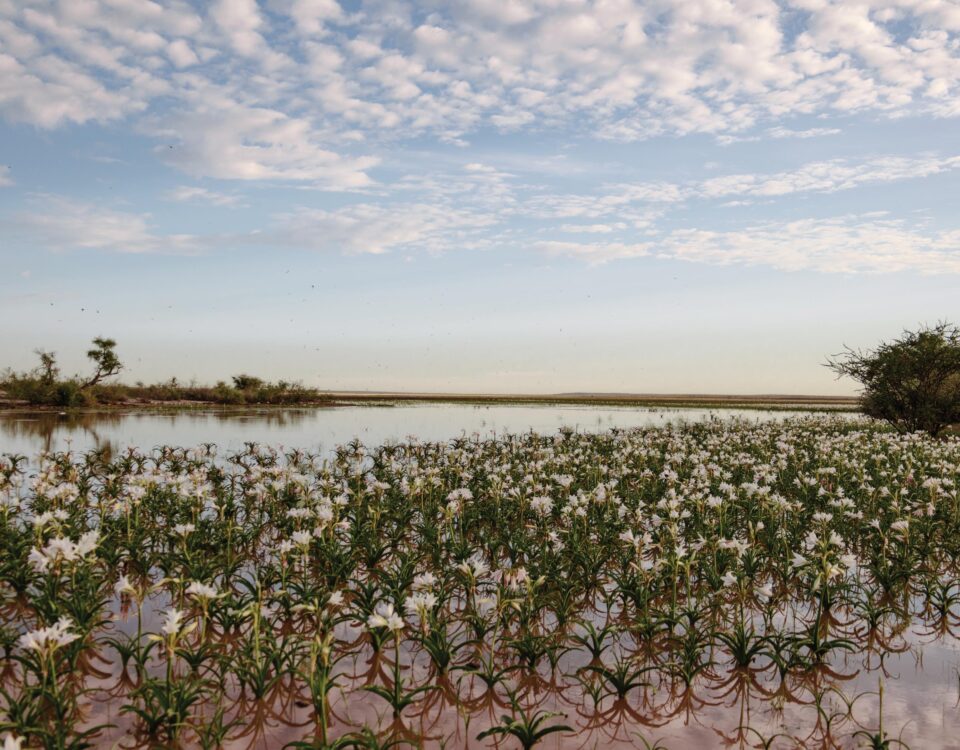By Hu Berry
Its scientific name Acanthosicyos horridus is more difficult to pronounce than its Topnaar name, !nara. The high-pitched Topnaar click precedes the Nama word ‘!na’, meaning ‘more than enough food’. Topnaar culture embraces this thorny, leafless, melon-bearing plant, with which Topnaar settlements in the Kuiseb riverbed bond closely.
Dutch settlers called them Topnaars, but they prefer ≠Aonin (people staying in faraway places and in marginal areas), proudly aligning themselves with the severe setting in which they have chosen to live. The !nara undoubtedly was there first, but approximately 300 ≠Aonin pastoralists and gatherers still inhabit the lower reaches of the Kuiseb’s dry riverine forest, which draws its moisture from the watershed starting about 40 kilometres west of Windhoek. They comprise mostly older people and children, while some of the 700 urban dwellers, including wage earners, return over weekends from their residence in Walvis Bay.
Stemming from the nomadic Hottentot ‘Strandlopers’ or Beachcombers, they carry the genes of one of Africa’s oldest cultures, the Khoi-Khoin, which means ‘men of men’. Out of necessity ≠Aonin became aligned with !nara, recognising its nutritional value to provide them with a measure of self-sufficiency in the Namib’s frugal food supply. Eight thousand years ago, long before written history came to Namibia, the probable forbearers of ≠Aonin left !nara seeds at Mirabib, an isolated ‘inselberg’ on the gravel plains of the desert. Merging the prickly plant into their culture, the ≠Aonin developed a unique property-rights system with this distant relative of the domestic melon. It ensured that a family was granted exclusive harvesting rights to identified !naras growing wild on dunes and the edges of the ephemeral river. This procedure of private ownership of plants was changed to open sharing by communities in the 1980s.
Botanists regard !nara as a keystone species of the desert. It is endemic to the Namib, growing nowhere else. Not only people, but also animals are reliant on it, providing food, and shelter for burrowing animals. The spiky shrub holds abundant protein and water for insects, reptiles, birds and mammals. Moreover, the black-backed jackal has developed a mutually beneficial relationship with !nara, proven by the fact that the distribution of jackals and !nara in the desert overlaps completely. Jackals swallow the seeds whole, distributing them via faeces over many kilometres. Cut open a ripe melon weighing about one kilogram, and 200 to 300 nutritious seeds, containing 30% fat and 50% oil, are exposed. When in full production, a single female can bear up to 500 melons and very old plants cover an area of more than 2 000 square metres. To achieve this takes several human lifetimes, and requires a water-rich taproot approaching 100 metres in length, which penetrates to a depth of 50 metres. This structure ensures that !nara can withstand the desiccation of the desert above ground, while keeping its extensive root system permanently immersed in deep moisture sources. But these abilities come at a cost. !Nara has foregone the luxury of leaves, substituting them with its distinctive thorns, which are in fact highly modified leaves. Male !naras have the ability to flower throughout the year, guaranteeing an abundant supply of pollen for colourful beetles and bees to complete the cycle of fertilisation.
So profound is their respect for !nara that ≠Aonin elders recite a poem of praise that reflects the roots of this ancient plant in their culture:
You round food with many thorns,
Foster mother of the Topnaar children,
Even when I’m far away I shall think of you,
You food of my ancestors,
I will never forget you,
There is no breast-feeding woman like you.
This article appeared in the 2009/10 edition of Conservation and the Environment in Namibia.
Hu Berry was a scientist, conservationist and specialist tour guide. He was one of Venture Publications’ most valued authors. Sadly he passed away in July 2011. To read more about him click here.


